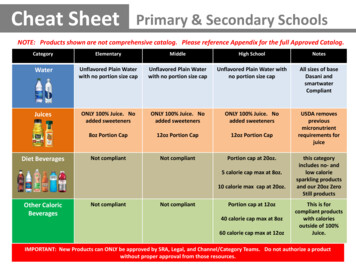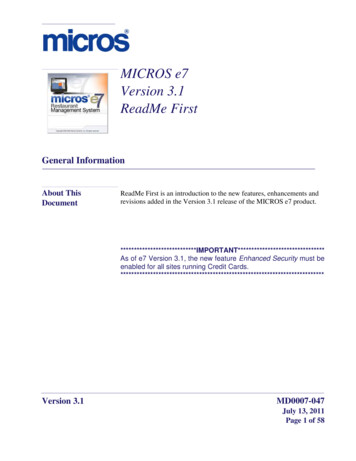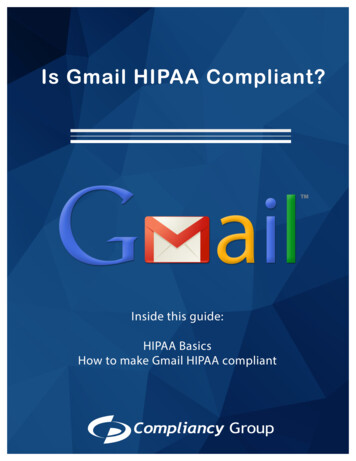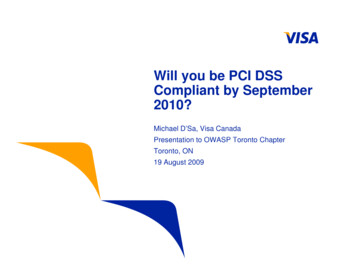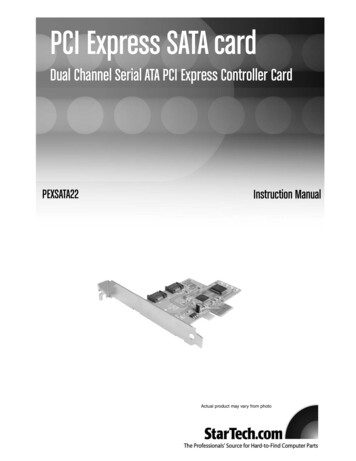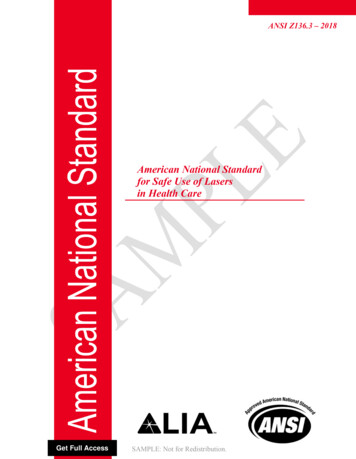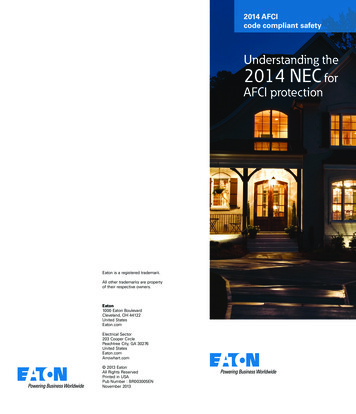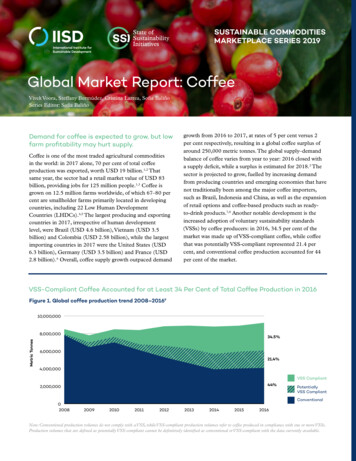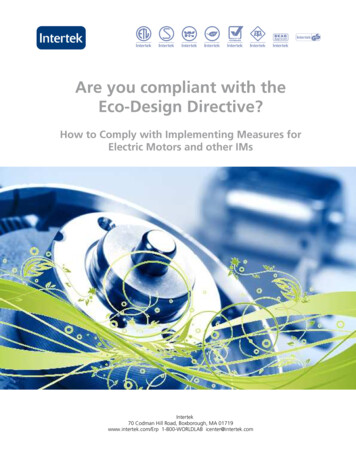
Transcription
Are you compliant with theEco-Design Directive?How to Comply with Implementing Measures forElectric Motors and other IMsIntertek70 Codman Hill Road, Boxborough, MA 01719www.intertek.com/Erp 1-800-WORLDLAB icenter@intertek.com
ContentsIntroduction . 3The Eco-Design Directive in Brief. 3Regulation (EC) No 640/2009 Eco-Design Requirements for Elactric Motors . 7Important Dates . 8Verification Procedure for Market Surveillence Purposes. 8How to comply with the Eco-Design Directive . 9Green Leaf Certification . 9Summary . 10About Intertek . 10Intertek70 Codman Hill Road, Boxborough, MA 01719www.intertek.com/Erp 1-800-WORLDLAB icenter@intertek.com
Eco-Design Directive (ErP): How toComply with Implementing Measuresfor Electric Motors and other IMsIntroductionThe Eco-design Directive for Energy-related Products (ErP) 2009/125/EC – formerlyknown as Energy-using Products (EuP) requires manufacturers and importers todemonstrate compliance with the Directive’s product category specific requirementsoutlined in the Implementing Measures (IMs). The ErP Directive is CE Markinglegislation, but differs from other EU legislation as it is intended to encompass theentire life cycle of energy related products.The directive’s Implementing Measures provide the specific compliancerequirements, segmented by approximately 30 product categories with moreproduct categories to be identified in the future.The Implementing Measures for motors (640/2009) entered into force on July 23rd2009 with specific requirements in three stages, starting in June 2011 and the lastfinishing in January 2017.This regulation covers electric motors (0,75 – 375kW) that can also be equippedwith a variable speed drive.The Eco-Design Directive in briefAs of November 20, 2009 the European Commission repealed the Eco-DesignDirective for Energy-using Products (EuP) 2005/32/EC, and replaced it with the morecomprehensive Energy-related Products (ErP) Directive 2009/125/EC. According tothe European Commission energy-related products are; “any goods having animpact on energy consumption during use." These include all energy-using products(televisions, microwaves, refrigerators), plus energy-conserving products (windows,insulation materials and water using products, like shower heads).The new ErP Directive encompasses both the products covered under the formerEuP Directive – those that use, generate, transfer or measure energy – and thosethat can contribute significant energy savings during use. The ErP Directive wasimplemented in each member state’s national law in fall 2010.www.intertek.com/ErP3
Eco-Design Directive (ErP): How toComply with Implementing Measuresfor Electric Motors and other IMsAs of November 20, 2009, the new Directive requires thatmanufacturers refer to the ErP Directive – not the EuP Directive– when marking products with a CE label. The so-calledImplementing Measures, which laid out the actual productrequirements to be met by product category for the EuPDirective, are still applicable.The EU Directive on Eco-design entered into force in August 2007 (then known asthe EuP Directive) and applies throughout the EU. The Eco-Design Directive aims toreduce the energy use and other negative environmental impacts throughout thelife cycle of products powered by electricity, fossil or renewable fuels as well asenergy-related products.According to the EU’s Official Journal, energy-related products account for a largeportion of the consumption of natural resources and energy in the community.Furthermore, many energy-related products have a significant potential for beingimproved in order to reduce environmental impacts and to achieve energy savingsthrough better design which also leads to economic savings for business and endusers.The Directive means that manufacturers must take into account energy use andother environmental factors in the product design. Both producers and importerswill be affected by the Directive. In order to use the CE mark to label products, andthus sell the products on the European market, the Directive requires adaptation ofyour products to meet the "Implementing Measures" that are currently beingdeveloped for different products. The first phase of the ErP Directive involves around30 product categories and more are likely to be affected in the future.Eco-Design Directive Scope: Product, Market, ProcessThe Directive applies to all products and/or product groups that require energy inorder to function as intended (excluding vehicles that transport humans or goods cars, trains, ships, and airplanes) as well as energy-related products such aswindows, insulation materials and water using products, like shower heads. Theproducts should fulfill the following criteria in order to be included in an action or tobe self-regulating:1. The product should represent a significant volume of sales and trade withinthe EU, namely, exceeding 200,000 market units across all manufacturerswww.intertek.com/ErP4
Eco-Design Directive (ErP): How toComply with Implementing Measuresfor Electric Motors and other IMs(this applies to the entire product group rather than individual products ormodels, or market volume of an individual manufacturer).2. The product should, in view of the quantities put on the market and/or used,have a substantial environmental impact within the EU.3. There should be significant opportunities for improving the product’senvironmental impact without incurring unreasonable costs, in view of thefact that:a. There is no other relevant common legislation for dealing with theproblem in a suitable manner and it cannot be solved by marketforces.b. There is a large difference in the environmental performance ofdifferent Energy using Products on the market with equivalentfunctions.c. A special method is used to assess whether and to what extentdifferent Energy-related Products fulfill these criteria and to outlinewhich eco-design requirements can be established for each specificproduct.The basic elements of the Eco-design requirement are compiled by a number ofgroups of experts engaged by the EU Commission, which then put forwardproposals for product requirements. The Commission reviews these on a productby-product basis and sends its proposals for product requirements in a customdocument to all EU Member States. The Implementing Measures will be introducedfor each product group either through national law or through a daughter directiveunder the Eco-design Directive for Energy-related Products (ErP).Eco-Design Directive AdoptionThe first Implementing Measures to be adopted were as follows, standby/off mode,simple set top boxes1, street and office lighting, non-directional household lampsand external power supplies.1A simple set top box is a stand-alone device which has the primary function of converting standard orhigh definition, free-to-air digital broadcast signals to analogue broadcast signals suitable for analogue televisionor radio without conditional access and may or may not have recording functions based on non-removablemedia storage.www.intertek.com/ErP5
Eco-Design Directive (ErP): How toComply with Implementing Measuresfor Electric Motors and other IMsOn July 22nd, 2009 the European Commission adopted four new eco-designregulations to improve the energy efficiency of 1) industrial motors, 2) circulators, 3)televisions, 4) refrigerators and freezers. According to the European Commission’swebsite, the four new energy efficiency requirements will save about 190 TWh peryear by 2020, which is comparable to the combined annual electricity consumptionof Sweden and Austria. In total nine eco-design Implementing Measures have beenadopted.www.intertek.com/ErP6
Eco-Design Directive (ErP): How toComply with Implementing Measuresfor Electric Motors and other IMsRegulation (EC) No 640/2009 Eco-Design Requirements forElectric MotorsElectric motors within EU has an annual electricityconsumption amounting to 1 067 TWh in 2005,corresponding to 427 Mt of CO2 emissions. In the absence ofmeasures to limit this consumption, it is predicted that energyconsumption will increase to 1 252 TWh in 2020. It has beenconcluded that the life-cycle energy consumption and the usephase electricity consumption can be improved significantly, in particular if motorsin variable speed and load applications are equipped with drives.The Regulation should increase the marketability of technologies that improve thelife-cycle environmental impact of electric motors, leading to estimated life-cycleenergy savings of 5 500 PJ and electricity savings of 135 TWh by 2020, compared tothe situation where no measures are taken.The first requirement for electric motors comes into effect on June 16th 2011. Thetype of electric motor covered under the regulation is the so-called induction motor,which is the most common motor type, accounting for 90 percent of electricityconsumption of all electric motors in the power range from 0.75 to 375 kW. Theseelectric motors are primarily found in fans, pumps and compressors as well as in airconditioner motors used in apartment buildings.Definition of MotorsMotor means an electric single speed, three-phase 50 Hz or 50/60 Hz, squirrel cageinduction motor that: has 2 to 6 poles has a rated voltage of U N up to 1 000 V has a rated output P N between 0,75 kW and 375 kW is rated on the basis of continuous duty operationwww.intertek.com/ErP7
Eco-Design Directive (ErP): How toComply with Implementing Measuresfor Electric Motors and other IMsAdditional ConsiderationsOnly motors that are put on the market for the first time are subject to therequirements. It does not apply to motors that have previously been placed on themarket and now have gone through reparation, unless the reparations are soextensive that it renders the product as practically new.Important DatesBeginning June 16, 2011 electric motors shall not be less efficient than the IE2efficiency level, the engines should then also have visible technical marking withamong other things nominal efficiency, efficiency level, information relevant fordisassembly, recycling or disposal at end-of-life.Beginning January 1, 2015, motors with a rated output of 7,5-375 kW shall not beless efficient than the IE3 efficiency level or meet the IE2 efficiency level if the motoris equipped with a variable speed drive (VSD). In the future, VSD too will have ecodesign requirements.Beginning January 1, 2017 all motors with a rated output of 0,75-375 kW shall notbe less efficient than the IE3 efficiency level or meet the IE2 efficiency level if themotors are equipped with a variable speed drive.Verification Procedure for Market Surveillance Purposes1. The authorities shall test one single unit.2. The model shall be considered to comply with the provisions set out in theregulation, if in the nominal motor efficiency (η), the losses (1-η) do not varyfrom the values set out in Annex I (ECODESIGN REQUIREMENTS FORMOTORS) by more than 15 % on power range 0,75-150 kW and 10 % onpower range 150-375 kW.3. If the result referred to in point 2 is not achieved, the market surveillanceauthority shall randomly test three additional units, except for motors thatare produced in lower quantities than five per year.4. The same model shall be considered to comply with the provisions set out inthis Regulation, if in the average of the nominal efficiency (η), the losses (1-η)of the three units referred to in point 3 do not vary from the values set out inwww.intertek.com/ErP8
Eco-Design Directive (ErP): How toComply with Implementing Measuresfor Electric Motors and other IMsAnnex I by more than 15 % on power range 0,75 to 150 kW and 10 % onpower range 150-375 kW.5. If the results referred to in point 4 are not achieved, the model shall beconsidered non-compliant with the Regulation.How to comply with the Eco-Design DirectiveThe Eco-design directive is an expansive environmental legislation. Intertek’s expertsin environmental legislation and product compliance have untangled the ErPDirective for you.We can assist you throughout the entire ErP compliance application process –including independent testing, environmental management systems support andother requirements for specific products – helping you to reach European marketssmoothly.Intertek’s ErP solutions for electric motors are:ErP Compliance Verification: Receive full verification of the Electric MotorsImplementing Measure and we will deliver a test report for your product’s technicalfile and Statement of Compliance for legal CE Marking.Green Leaf CertificationIntertek's Green Leaf Mark is proof that a product has beenindependently tested and found to conform to multiple existingenvironmental regulations, such as the Eco-Design Directive, RoHSlaws, REACH and other requirements through one mark rather thanmultiple marks.The Green Leaf Mark is used on product packaging, in point of purchase displays,product advertising and literature to explain a product’s environmental credentials.Contact your local office for more information.Intertek’s other ErP solutions are:ErP Training & Consulting: Learn what your quickest and most cost-efficientcompliance options are. We’ll tell you if, when, and how ErP will affect yourproduct.ErP Software Analysis: Let Intertek perform an analysis of your product’sEcological profile according to the ErP directive specifications.www.intertek.com/ErP9
Eco-Design Directive (ErP): How toComply with Implementing Measuresfor Electric Motors and other IMsErP Pre-Compliance Verification: Learn how your product measures up againstproposed and future ErP regulations for R&D purposes, compliance planning and todetermine market readiness.Intertek services also cover other electric motor products.SummaryCompliance with the Eco-Design Directive is a priority for all manufacturers andproducers working with energy-related projects. If you would like to know howIntertek can partner and help you establish ErP solutions, please contact Intertektoday at 1-800-WORLDLAB or icenter@intertek.com.About IntertekIntertek is a leading provider of quality and safety solutions serving a wide range of industries around the world.From auditing and inspection, to testing, quality assurance and certification, Intertek people are dedicated toadding value to customers' products and processes, supporting their success in the global marketplace. Intertekhas the expertise, resources and global reach to support its customers through its network of more than 1,000laboratories and offices and over 26,000 people in more than 100 countries around the world. Intertek Groupplc (ITRK) is listed on the London Stock Exchange in the FTSE 100 index.This publication is copyright Intertek and may not be reproduced or transmitted in any form in whole or in partwithout the prior written permission of Intertek. While due care has been taken during the preparation of thisdocument, Intertek cannot be held responsible for the accuracy of the information herein or for anyconsequence arising from it. Clients are encouraged to seek Intertek’s current advice on their specific needsbefore acting upon any of the content.www.intertek.com/ErP10
The Eco-design Directive for Energy-related Products (ErP) 2009/125/EC - formerly known as Energy-using Products (EuP) requires manufacturers and importers to demonstrate compliance with the Directive's product category specific requirements




